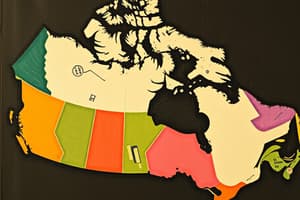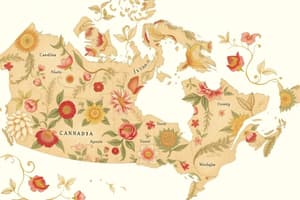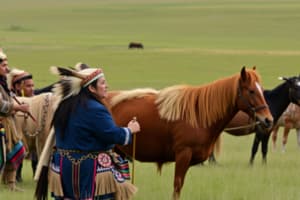Podcast
Questions and Answers
Which geographical feature significantly influences the climate of the Canadian prairie by allowing strong winds?
Which geographical feature significantly influences the climate of the Canadian prairie by allowing strong winds?
- Numerous large lakes
- Mountain ranges in the east
- Absence of natural barriers like trees or mountains (correct)
- Dense forest coverage
What climatic condition is characteristic of Winnipeg during the winter season?
What climatic condition is characteristic of Winnipeg during the winter season?
- Consistent rainfall instead of snow
- Severe cold with temperatures dropping well below -20°C and heavy snowfall (correct)
- Temperatures frequently above freezing
- Mild temperatures and light snowfall
Which statement accurately describes the temperature variations in the Canadian prairie region?
Which statement accurately describes the temperature variations in the Canadian prairie region?
- Summers are short and cool, while winters are long and mild.
- Summers are warm, and winters are extremely cold. (correct)
- Temperatures remain consistent throughout the year.
- Summers are mild, and winters are moderately cold.
In which sub-region of the North American prairie is tallgrass prairie primarily located?
In which sub-region of the North American prairie is tallgrass prairie primarily located?
Which factor most limits the growth of trees in the prairie region?
Which factor most limits the growth of trees in the prairie region?
The 'chinook' wind is characterized by what?
The 'chinook' wind is characterized by what?
Which of the following best describes the typical annual rainfall in the Canadian grasslands?
Which of the following best describes the typical annual rainfall in the Canadian grasslands?
What role do forest fires play in the prairie ecosystem?
What role do forest fires play in the prairie ecosystem?
Which animal is considered native to the Canadian prairie region?
Which animal is considered native to the Canadian prairie region?
Why is Winnipeg known as 'the gateway to the prairie'?
Why is Winnipeg known as 'the gateway to the prairie'?
In which part of North America is the mixed prairie primarily situated?
In which part of North America is the mixed prairie primarily situated?
What type of vegetation dominates the Canadian prairie?
What type of vegetation dominates the Canadian prairie?
Which of the following animals helps to convert dead foliage into nutritious ash for the grasses?
Which of the following animals helps to convert dead foliage into nutritious ash for the grasses?
Which province is NOT part of the Canadian prairie?
Which province is NOT part of the Canadian prairie?
What is the average temperature during summers in the Canadian prairie?
What is the average temperature during summers in the Canadian prairie?
Willows, alders, and poplars are commonly found in which type of area within the prairie region?
Willows, alders, and poplars are commonly found in which type of area within the prairie region?
What is the position of Rocky Mountains from where the local dry and warm foehn-type wind 'the chinook' blows?
What is the position of Rocky Mountains from where the local dry and warm foehn-type wind 'the chinook' blows?
What is the temperature the mercury drops to during winters in Winnipeg, Canada?
What is the temperature the mercury drops to during winters in Winnipeg, Canada?
Which of the following conditions allows for the formation of some woodlands in patches in the Canadian Prairies?
Which of the following conditions allows for the formation of some woodlands in patches in the Canadian Prairies?
The tributaries of which river commonly drains the Canadian prairie?
The tributaries of which river commonly drains the Canadian prairie?
Flashcards
Canadian Prairie Location
Canadian Prairie Location
The Canadian prairie is drained by tributaries and extends over Alberta, Saskatchewan, Manitoba, and Ontario.
Prairie Sub-Regions
Prairie Sub-Regions
Tallgrass prairie (east), mixed prairie (center), and short grass prairie (west).
Prairie Climate
Prairie Climate
Marked by extreme conditions, warm summers (20°C avg), and severely cold winters (below -20°C).
Chinook Wind
Chinook Wind
Signup and view all the flashcards
Prairie Vegetation
Prairie Vegetation
Signup and view all the flashcards
Prairie Wildlife
Prairie Wildlife
Signup and view all the flashcards
Prairie Rainfall
Prairie Rainfall
Signup and view all the flashcards
Study Notes
- The Canadian prairie is drained by the tributaries of the Saskatchewan River.
- It extends over the provinces of Alberta, Saskatchewan, Manitoba, and Ontario.
- Winnipeg (Canada) is known as 'the gateway to the prairie'.
- The North American prairie has three sub-regions:
- Tallgrass prairie (in the east)
- Mixed prairie (in the centre)
- Short grass prairie (in the west)
Climate
- Experience extreme climatic conditions due to its location in the continent's interior.
- Summers are warm, averaging 20° C.
- Winters are extremely cold, falling below -20° C.
- Winnipeg winters are severe, with heavy snowfall and mercury dropping below -34° C.
- Rainfall is moderate, around 50 cm annually.
- Absence of natural barriers causes strong winds.
- The Chinook, a foehn-type wind, blows eastwards from the Rocky Mountains.
Natural Vegetation
- Primarily dominated by various grasses.
- Trees are scarce, limited to woodland patches with sufficient water and warmth.
- Common trees: willows, alders, and poplars.
- Limited tree numbers due to droughts and forest fires (lightning & human-caused).
- Fire converts dead foliage to nutritious ash for grasses.
Wildlife
- Native animals: American buffalo (bison), badger, coyote (prairie wolf), fox, antelope, prairie dog, rabbit, and gopher.
Studying That Suits You
Use AI to generate personalized quizzes and flashcards to suit your learning preferences.




